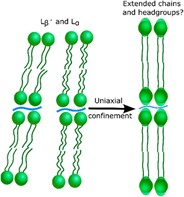
Supported lipid bilayers are used in much of our research, as a matrix for membrane mimics, supporting polymer brushes, etc. Their behaviour under confinement under various conditions is also of interest in itself in order to understand, the electric double layer when charged (Wieser et al. https://doi.org/10.1021/acs.jpclett.1c02572), their lubrication properties such as in joints and decouple the effects of the matrix from the molecules of interest in our complex systems. I am also interested in stacks of lipid bilayers, which have applications in the body such as in myelin sheaths around nerves and in the skin. Neutron reflectometry is a powerful technique for studying features such as the thickness and hydration of lipid layers at interfaces.
Our recent beam time (awarded by the Institut Laue-Langevin, Grenoble, France) used a confinement cell developed in Bristol to look at lipid supported polymer brushes under confinement. Previously I have used the cell for discovering changes in the phase behaviour of lipid stacks (see Mears et al https://doi.org/10.3389/fphy.2021.703472) and we look forward to complementing this work with surface forces apparatus and quartz crystal microbalance studies in our lab here in Vienna to further understanding these wide ranging topics.
GENERAL INFO:Contact: Dr. Laura Mears

